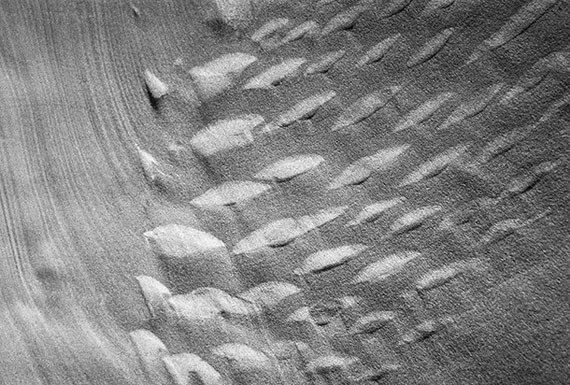
Textures in the sand
1934
Silver gelatin print
16,1 x 23,8 cm
© Alfred Ehrhardt Stiftung
100 years of bauhaus IV: THE CURONIAN SPIT
100 jahre bauhaus IV : DIE KURISCHE NEHRUNG
Alfred Ehrhardt » Kazimieras Mizgiris »
Exhibition: 21 Sep – 22 Dec 2019
Fri 20 Sep 19:00 - 21:00

Alfred Ehrhardt Stiftung
Auguststr. 75
10117 Berlin
+49 (0)30-20095333
info@aestiftung.de
www.aestiftung.de
Tue-Sun 11-18
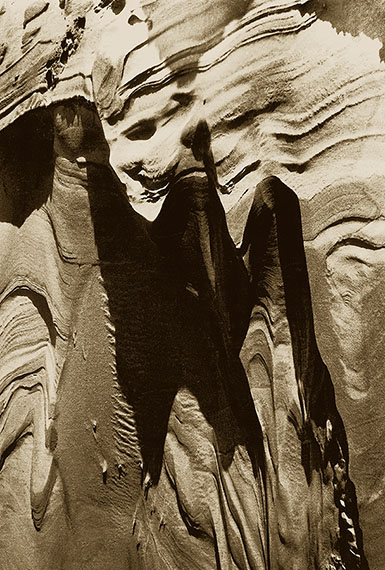
Wind + Sand. Curonian Spit
1976-2000
silver gelatin print
29 x 22 cm
© Kazimieras Mizgiris
Kazimieras Mizgiris | Alfred Ehrhardt
"THE CURONIAN SPIT"
Exhibition: 21 September – 22 December, 2019
Opening: Friday, 20 September, 7–9 pm
The Curonian Spit, with its unique, drifting sand dunes and sand formations reshaped daily by the wind, has fascinated and inspired generations of writers, artists, and photographers. The spit’s ninety-six-kilometer-long strip of sand dunes was once part of East Prussia and today belongs to Russia and Lithuania.
The exhibition, the fourth in the "100 years of bauhaus" series, showcases the photographic work of the Lithuanian amber collector and photographer Kazimieras Mizgiris (b. 1950). Based in Nida, the artist’s intimate knowledge of sand-dune formations on the Curonian Spit is unrivalled. For decades, he has visited the drifting dunes of the "Baltic Sahara"—located just outside his front door—with his camera early in the morning, primarily in spring and autumn. His images of bizarre formations recalling prehistoric animals, produced by the interplay of wind, sand, and ice, are unique given the short-lived nature of the formations. Created in the spring when frozen water in the sand thaws, they leave behind icy sand-stelea that melt over the course of the day in the sunlight, crumble in the wind, and finally collapse.
These are presented alongside Alfred Ehrhardt’s abstract photographs of the Curonian Spit from 1934, which, in contrast to Mizgiris’s images, evince the strict formal vocabulary of a structuralist trained at the Bauhaus in Dessau. As his 1938 book "Die Kurische Nehrung" (The Curonian Spit) describes, his intention was less about "portraying a 'beautiful' landscape, than it was tapping into the vastness of a still-pristine and primeval landscape. [...] The clarity of nature’s crystalline, formal language has always been man’s greatest teacher."
Mizgiris has experienced the history of the Curonian Spit as a story of man’s struggle with the sand. The Baltic Sea tosses sand up onshore where it is picked up by the wind and blown into huge dunes. If precautionary measures are not taken, houses can be knocked over by the swirling sand. In his book "Wind and Sand" (2000) the photographer writes: “You need persistence to catch the moment when a miracle is performed by the sea, the wind, the sun, and the clouds. You have to wait until the little cloud over the dunes takes the shape and casts the shadow you want. I have my favorite paths and spots in the dunes. I can feel them, because they are alive. […] Real fossils can be millions of years old; the fossils in my pictures live for a moment or two. Nature creates all this in incredible ways.”
Whereas Ehrhardt seeks to examine the laws of form creation in depth, Mizgiris evokes a relationship between forms and primeval structures in his photographs in order to portray the temporally transcendent character of this ever-changing spit of landscape. Both photographers express their fascination with the natural forms of this extraordinary primeval landscape.
Accompanying the exhibition is the publication "Kazimieras Mizgiris. Wind + Sand. Curonian Spit", released by Kehrer Verlag.
Exhibition events:
September 22, 2019, 2 pm:
Guided tour of the exhibition and conversation between Christiane Stahl and
Lithuanian photographer Kazimieras Mizgiris (in German)
October 30, 2019, 7 pm:
"Not a 'Beautiful' Landscape—Alfred Ehrhardt’s book The Curonian Spit (1938) in the Context of Time,"
slide lecture by Dr. Eva Pluharova (in German)
November 27, 2019, 7 pm:
the Literaturhaus der Fotografie series presents
"I have a strong sympathy for this landscape."
Frank Arnold reads texts by Thomas Mann and others about Nida and the Curonian Spit.
Moderated by Thomas Böhm (radioeins: Die Literaturagenten) (in German)
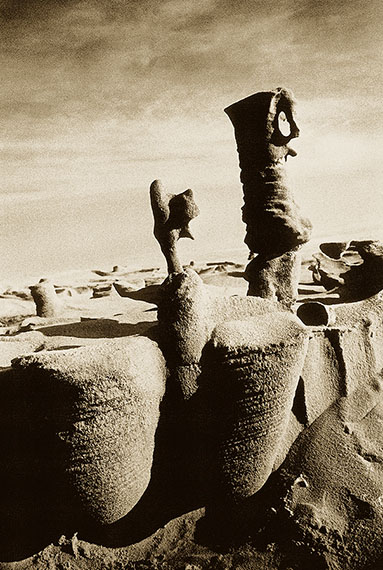
Wind + Sand. Curonian Spit
1976-2000
silver gelatin print
25,5 x 15 cm
© Kazimieras Mizgiris
Kazimieras Mizgiris | Alfred Ehrhardt
"Die Kurische Nehrung"
Ausstellung: 21. September bis 22. Dezember 2019
Eröffnung: Freitag, 20. September, 19–21 Uhr
Die Kurische Nehrung mit ihren einzigartigen Wanderdünen und vom Wind täglich neu gestalteten Sandformationen hat schon Generationen von Literaten, Künstlern und Fotografen fasziniert und inspiriert. Früher gehörte der 96 Kilometer lange Dünenstreifen der Nehrung zu Ostpreußen, heute zu Russland und Litauen.
Im Zentrum der IV. Ausstellung der Reihe "100 jahre bauhaus" steht das fotografische Werk des litauischen Bernsteinsammlers und Fotografen Kazimieras Mizgiris (* 1950), der die Dünenformationen der Kurischen Nehrung kennt wie kaum ein anderer. Über Jahrzehnte hinweg besucht er früh am Morgen mit seiner Kamera – vorwiegend im Frühling und Herbst – die direkt vor seiner Haustür liegenden Wanderdünen der "Baltischen Sahara". Seine Aufnahmen bizarrer Formationen, urzeitlichen Tieren ähnelnd, gestaltet durch das Zusammenspiel von Wind, Sand und Eis, sind auch deswegen einzigartig, weil sie sehr kurzlebig sind. Sie entstehen, wenn das im Sand gefrorene Wasser im Frühjahr taut und Eissandstelen zurück bleiben, die im Laufe des Tages durch die Sonneneinstrahlung schmelzen, durch den Wind abbröckeln und schließlich in sich zusammenfallen.
Dem gegenüber gestellt werden Alfred Ehrhardts abstrakte Aufnahmen von der Kurischen Nehrung aus dem Jahr 1934, die im Gegensatz zu Mizgiris‘ Bildern das strenge Formenvokabular eines am Dessauer Bauhaus geschulten Strukturalisten aufweisen.
Wie in seinem 1938 erschienenen Buch "Die Kurische Nehrung" beschrieben, wollte er weniger "eine 'schöne' Landschaft zur Darstellung bringen, als vielmehr die Größe einer Landschaft erschließen, die noch unberührt und urhaft ist. […] Die Natur ist in ihrer kristallisch klaren Formensprache allzeit der größte Lehrmeister der Menschen gewesen".
Mizgiris hat die Geschichte der Kurischen Nehrung erlebt als eine Geschichte vom Kampf des Menschen mit dem Sand. Die Ostsee wirft den Sand ans Ufer, der Wind hebt ihn auf und bläst ihn zu einer riesigen Wanderdüne zusammen. Wenn der Mensch keine Vorsorgemaßnahmen trifft, wird sein Haus von dem umhertreibenden Sand zugeweht. In seinem Buch "Wind und Sand" (2000) schreibt der Fotograf: "Man braucht Geduld, um den Augenblick abzupassen, wenn das Wunder der Entstehung von Meer, Wind, Sonne und Wolken in den Sandfeldern geschieht. Man muß warten, bis eine Wolke sich über den Dünen formt und bis der Schatten dorthin zieht, wo man ihn braucht. In den Dünen habe ich meine Wege, meine Jagdgründe. Ich spüre, wie die Dünen leben – sie sind wirklich lebendig. […] Die wirklichen Fossilien sind Millionen von Jahren alt – meine nur wenige Augenblicke. Es ist die Natur selbst, die all das ganz unerwartet wiederholt."
Während Ehrhardt versucht, den Gesetzmäßigkeiten der Formenbildung auf den Grund zu gehen, suggeriert Mizgiris in seinen Fotografien die Verwandtschaft der Formen mit urzeitlichen Gebilden, um das Überzeitliche dieser sich ständig wandelnden Nehrungslandschaft zu charakterisieren. Beide Fotografen drücken ihre Faszination für die Naturformen dieser außergewöhnlichen Urlandschaft aus.
Zur Ausstellung erscheint die Publikation "Kazimieras Mizgiris. Wind + Sand. Kurische Nehrung" im Kehrer Verlag.
Veranstaltungen zur Ausstellung:
22. September 2019, 14 Uhr:
Führung durch die Ausstellung und Künstlergespräch
Dr. Christiane Stahl mit dem litauischen Fotografen Kazimieras Mizgiris [in deutscher Sprache]
30. Oktober 2019, 19 Uhr:
"Keine 'schöne' Landschaft – Alfred Ehrhardts Buch Die Kurische Nehrung (1938) im Kontext der Zeit"
Lichtbildervortrag Dr. Eva Pluharova
27. November 2019, 19 Uhr:
In der Reihe "Literaturhaus der Fotografie"
"Ich habe eine starke Sympathie für diese Landschaft."
Frank Arnold liest Texte von Thomas Mann und anderen über Nidden und die Kurische Nehrung.
Moderation: Thomas Böhm (radioeins: Die Literaturagenten)
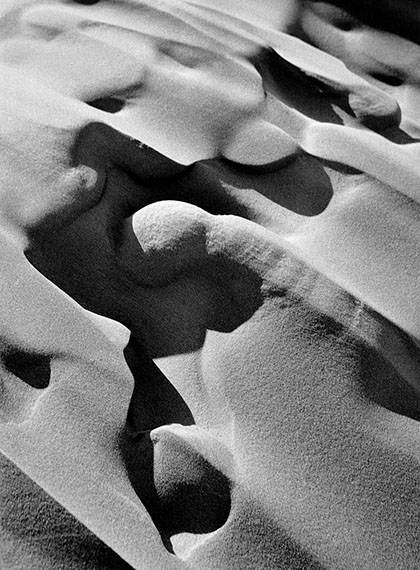
Textures in the sand
1934
silver gelatin print
23,4 x 17,5 cm
© Alfred Ehrhardt Stiftung
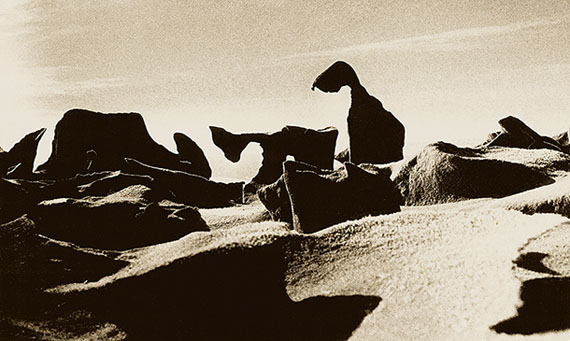
Wind + Sand. Curonian Spit
1976-2000
silver gelatin print
15,5 x 25,5 cm
© Kazimieras